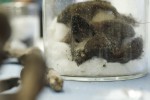 In 2010, the astronomer’s coffin was exhumed from his tomb in Our Lady Before Tyn Church in Prague. Several samples of hair, teeth, bone and textile were taken and the remains were reburied four days later. Researchers from Aarhus University, the University of Southern Denmark and the Nuclear Physics Institute in Prague have been analyzing the samples ever since. In 2012 they confirmed that Brahe did not die from Mercury poisoning, an idea that had been floating about since a 1901 exhumation found elevated levels of mercury in his remains. It turns out, they weren’t particularly elevated at all right before his death or in the years leading up to it.
In 2010, the astronomer’s coffin was exhumed from his tomb in Our Lady Before Tyn Church in Prague. Several samples of hair, teeth, bone and textile were taken and the remains were reburied four days later. Researchers from Aarhus University, the University of Southern Denmark and the Nuclear Physics Institute in Prague have been analyzing the samples ever since. In 2012 they confirmed that Brahe did not die from Mercury poisoning, an idea that had been floating about since a 1901 exhumation found elevated levels of mercury in his remains. It turns out, they weren’t particularly elevated at all right before his death or in the years leading up to it.
 But it was another element that was found in surprising abundance: gold. The latest analyses have found that Tycho Brahe had gold in hair and lots of it. Tests of three different hair samples had gold content 20 to 100 times higher than the norm today.
But it was another element that was found in surprising abundance: gold. The latest analyses have found that Tycho Brahe had gold in hair and lots of it. Tests of three different hair samples had gold content 20 to 100 times higher than the norm today.
There are no natural sources that could explain this high level of exposure to gold, such as soil or water, which means that Brahe must have been regularly exposed to gold in his everyday life.
“It may have been the cutlery and plates of gold, or maybe the wine he drank contained gold leaf. It’s also possible that he concocted and consumed elixirs containing gold, or that he worked with alchemy,” [University of Southern Denmark professor Kaare Lund] Rasmussen said.
 Diane de Poitier, mistress of King Henry II of France, took a daily dose of gold for years. The theory was that gold’s purity and incorruptibility would be conveyed to Diane, keeping her young and beautiful. Instead it made her bones and hair brittle. When she died in 1566, 35 years before Tycho Brahe, the concentration of gold in her remains was 500 times greater than in a lock of her hair cut when she was a young woman. It may well be what killed her.
Diane de Poitier, mistress of King Henry II of France, took a daily dose of gold for years. The theory was that gold’s purity and incorruptibility would be conveyed to Diane, keeping her young and beautiful. Instead it made her bones and hair brittle. When she died in 1566, 35 years before Tycho Brahe, the concentration of gold in her remains was 500 times greater than in a lock of her hair cut when she was a young woman. It may well be what killed her.
Brahe probably wasn’t taking gold to capture eternal youth. His exposure was more likely scientific. Samples from his hair, beard, eyebrows and bones were tested for another 14 elements and the results also showed higher-than-average concentrations of iron, cobalt, arsenic and silver. All of those would have been commonly used in alchemical experiments and in the preparation of medicines.
The concentration of metals is lower in the younger parts of the hairs, which allows the researchers to conclude that he was not exposed to these metals approximately the last 2 months before his death. The reason for that may be that he was too weak to work in his laboratory in his final weeks and months.
“What this tells us is that he did not suffer from an acute and fatal poisoning. This is not a particularly unusual cause of death in a period where the toxicity of metals was still unknown. Sir Isaac Newton, for instance, was subjected to mercury and lead poisoning,” Rasmussen explained.
So we still don’t know Tycho Brahe’s cause of death, but we can cross poisoning off the list. Researchers also found no evidence of metabolic diseases. The study has been published in the journal Archaeometry and can be read in its entirety here.